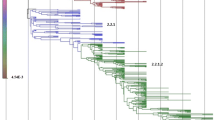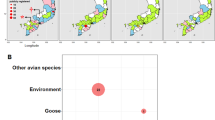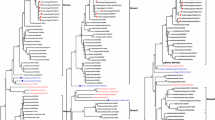Abstract
During 2009–2012, several outbreaks of avian influenza virus H9N2 were reported in Tunisian poultry. The circulating strains carried in their hemagglutinins the human-like marker 226L, which is known to be important for avian-to-human viral transmission. To investigate the origins and zoonotic potential of the Tunisian H9N2 viruses, five new isolates were identified during 2012–2016 and their whole genomes were sequenced. Bayesian-based phylogeny showed that the HA, NA, M and NP segments belong to the G1-like lineage. The PB1, PB2, PA and NS segments appeared to have undergone multiple intersubtype reassortments and to be only distantly related to all of the Eurasian lineages (G1-like, Y280-like and Korean-like). The spatiotemporal dynamic of virus spread revealed that the H9N2 virus was transferred to Tunisia from the UAE through Asian and European pathways. As indicated by Bayesian analysis of host traits, ducks and terrestrial birds played an important role in virus transmission to Tunisia. The subtype phylodynamics showed that the history of the PB1 and PB2 segments was marked by intersubtype reassortments with H4N6, H10N4 and H2N2 subtypes. Most of these transitions between locations, hosts and subtypes were statistically supported (BF > 3) and not influenced by sampling bias. Evidence of genetic evolution was observed in the predicted amino acid sequences of the viral proteins of recent Tunisian H9N2 viruses, which were characterized by the acquisition of new mutations involved in virus adaptation to avian and mammalian hosts and amantadine resistance. This study is the first comprehensive analysis of the evolutionary history of Tunisian H9N2 viruses and highlights the zoonotic risk associated with their circulation in poultry, indicating the need for continuous surveillance of their molecular evolution.




Similar content being viewed by others
References
Rejmanek D, Hosseini PR, Mazet JA, Daszak P, Goldstein T (2015) Evolutionary dynamics and global diversity of influenza A virus. J Virol 89(21):10993–11001. https://doi.org/10.1128/JVI.01573-15
Shao W, Li X, Goraya MU, Wang S, Chen JL (2017) Evolution of influenza A virus by mutation and re-assortment. Int J Mol Sci 18(8):1650. https://doi.org/10.3390/ijms18081650
Iqbal M, Yaqub T, Mukhtar N, Shabbir MZ, McCauley JW (2013) Infectivity and transmissibility of H9N2 avian influenza virus in chickens and wild terrestrial birds. Vet Res 44(1):100. https://doi.org/10.1186/1297-9716-44-100
Yoon SW, Webby RJ, Webster RG (2014) Evolution and ecology of influenza A viruses. Curr Top Microbiol Immunol 385:359–375
Homme PJ, Easterday BC (1970) Avian influenza virus infections. I. Characteristics of influenza A/Turkey/ Wisconsin/1966 virus. Avian Dis 14(1):66–74
Shortridge KF (1992) Pandemic influenza: a zoonosis? Semin Respir Infect 7(1):11–25
Sun Y, Liu J (2015) H9N2 influenza virus in China: a cause of concern. Protein Cell. 6(1):18–25. https://doi.org/10.1007/s13238-014-0111-7
Butt AM, Siddique S, Idrees M et al (2010) Avian influenza A (H9N2): computational molecular analysis and phylogenetic characterization of viral surface proteins isolated between 1997 and 2009 from the human population. Virol J 7:319. https://doi.org/10.1186/1743-422X-7-319
Lee CW, Song CS, Lee YJ, Mo IP, Garcia M, Suarez DL, Kim SJ (2000) Sequence analysis of the hemagglutinin gene of H9N2 Korean avian influenza viruses and assessment of the pathogenic potential of isolate MS96. Avian Dis 44:527–535
Li C, Wang S, Bing G et al (2017) Genetic evolution of influenza H9N2 viruses isolated from various hosts in China from 1994 to 2013. Emerg Microbes Infect. 6(11):e106. https://doi.org/10.1038/emi.2017.94
Yang J, Müller NF, Bouckaert R, Xu B, Drummond AJ (2019) Bayesian phylodynamics of avian influenza A virus H9N2 in Asia with time-dependent predictors of migration. PLoS Comput Biol 15(8):e1007189. https://doi.org/10.1371/journal.pcbi.1007189
Nagy A, Mettenleiter TC, Abdelwhab EM (2017) A brief summary of the epidemiology and genetic relatedness of avian influenza H9N2 virus in birds and mammals in the Middle East and North Africa. Epidemiol Infect 145:3320–3333
Gu M, Xu L, Wang X, Liu X (2017) Current situation of H9N2 subtype avian influenza in China. Vet Res. 48(1):49. https://doi.org/10.1186/s13567-017-0453-2
Butt KM, Smith GJ, Chen H et al (2005) Human infection with an avian H9N2 influenza A virus in Hong Kong in 2003. J Clin Microbiol 43(11):5760–5767. https://doi.org/10.1128/JCM.43.11.5760-5767.2005
Choi YK, Ozaki H, Webby RJ et al (2004) Continuing evolution of H9N2 influenza viruses in Southeastern China. J Virol 78(16):8609–8614. https://doi.org/10.1128/JVI.78.16.8609-8614.2004
Wan H, Sorrell EM, Song H et al (2008) Replication and transmission of H9N2 influenza viruses in ferrets: evaluation of pandemic potential. PLoS One. 3(8):e2923. https://doi.org/10.1371/journal.pone.0002923
Yong-Feng Z, Fei-Fei D, Jia-Yu Y et al (2017) Intraspecies and interspecies transmission of mink H9N2 influenza virus. Sci Rep 7(1):7429. https://doi.org/10.1038/s41598-017-07879-1
Zhang K, Zhang Z, Yu Z et al (2013) Domestic cats and dogs are susceptible to H9N2 avian influenza virus. Virus Res 175(1):52–57
Lloren KKS, Lee T, Kwon JJ, Song MS (2017) Molecular markers for interspecies transmission of avian influenza viruses in mammalian hosts. Int J Mol Sci 18(12):2706. https://doi.org/10.3390/ijms18122706
Wan H, Perez DR (2007) Amino acid 226 in the hemagglutinin of H9N2 influenza viruses determines cell tropism and replication in human airway epithelial cells. J Virol 81:5181–5191. https://doi.org/10.1128/JVI.02827-06
Alexander PE, De P, Rave S (2009) Is H9N2 avian influenza virus a pandemic potential? Can J Infect Dis Med Microbiol 20(2):e35–e36. https://doi.org/10.1155/2009/578179
Tombari W, Paul M, Bettaieb J, Larbi I, Nsiri J, Elbehi I, Gribaa L, Ghram A (2013) Risk factors and characteristics of low pathogenic avian influenza virus isolated from commercial poultry in Tunisia. PLoS One 8(1):e53524
Tombari W, Nsiri Larbi I, Guerin JL, Ghram A (2011) Genetic evolution of low pathogenecity H9N2 Avian influenza viruses in Tunisia: acquisition of new mutations. Virol J 8:467
Aouini R, Laamiri N, Ghram A (2016) Novel gene mutations in Tunisian isolate of avian H9N2 influenza virus. J Vet Sci Technol. 8:1
OIE (2016) Avian Influenza (Infection with Avian Influenza Viruses). Manual of Diagnostic Tests and Vaccines for Terrestrial Animals. Available from: http://www.oie.int/fileadmin/Home/eng/Health_standards/tahm/2.03.04_AI.pdf
Ben Shabat M, Meir R, Haddas R et al (2010) Development of a real-time TaqMan RT-PCR assay for the detection of H9N2 avian influenza viruses. J Virol Methods 168(1–2):72–77. https://doi.org/10.1016/j.jviromet.2010.04.019
Zhou B, Donnelly ME, Scholes DT et al (2009) Single-reaction genomic amplification accelerates sequencing and vaccine production for classical and Swine origin human influenza a viruses. J Virol 83(19):10309–10313. https://doi.org/10.1128/JVI.01109-09
Andrews S (2010) FastQC: a quality control tool for high throughput sequence data. Available online at: http://www.bioinformatics.babraham.ac.uk/projects/fastqc.
Hunt M, Gall A, Ong SH et al (2015) IVA: accurate de novo assembly of RNA virus genomes. Bioinformatics 31(14):2374–2376. https://doi.org/10.1093/bioinformatics/btv120
Hall TA (1999) BioEdit: a user-friendly biological sequence alignment editor and analysis for Windows 95/98/NT. Nucleic Acids Symp 41:95–98
Guindon S, Gascuel O (2003) A simple, fast and accurate algorithm to estimate large phylogenies by maximum likelihood. Syst Biol 52:696–704
Rambaut A, Lam TT, Max Carvalho L, Pybus OG (2016) Exploring the temporal structure of heterochronous sequences using TempEst (formerly Path-O-Gen). Virus Evol 2(1):7
Drummond AJ, Rambaut A (2007) BEAST: Bayesian evolutionary analysis by sampling trees. BMC Evol Biol 7:214. https://doi.org/10.1186/1471-2148-7-214
Baele G, Li WLS, Drummond AJ, Suchard MA, Lemey P (2013) Accurate model selection of relaxed molecular clocks in Bayesian phylogenetics. Mol Biol Evol 30(2):239–243
Fusaro A, Monne I, Salviato A et al (2011) Phylogeography and evolutionary history of reassortant H9N2 viruses with potential human health implications. J Virol 85(16):8413–8421. https://doi.org/10.1128/JVI.00219-11
Rambaut A, Drummond AJ, Xie D, Baele G, Suchard MA (2018) Posterior summarisation in Bayesian phylogenetics using Tracer 1.7. Syst Biol. https://doi.org/10.1093/sysbio/syy032
Bielejec F, Rambaut A, Suchard MA, Lemey P (2011) SPREAD: spatial phylogenetic reconstruction of evolutionary dynamics. Bioinformatics 27(20):2910–2912. https://doi.org/10.1093/bioinformatics/btr481
Hicks JT, Dimitrov KM, Afonso CL et al. (2019) Global phylodynamic analysis of avian paramyxovirus-1 provides evidence of inter-host transmission and intercontinental spatial diffusion. BMC Evol Biol 19(108).
DeLano WL (2002) Pymol: an open-source molecular graphics tool. CCP4 Newsl Protein Crystallogr 40:82–92.
Li C, Yu K, Tian G, Yu D, Liu L, Jing B, Ping J, Chen H (2005) Evolution of H9N2 influenza viruses from domestic poultry in Mainland China. Virology 340(1):70–83
Gabriel G, Abram M, Keiner B, Wagner R, Klenk HD, Stech J (2007) Differential polymerase activity in avian and mammalian cells determines host range of influenza virus. J Virol 81:9601–9604
Hulse-Post DJ, Franks J, Boyd K, Salomon R, Hoffmann E, Yen HL et al (2007) Molecular changes in the polymerase genes (PA and PB1) associated with high pathogenicity of H5N1 influenza virus in mallard ducks. J Virol 81:8515–8524
Liu Q, Lu L, Sun Z, Chen GW, Wen Y, Jiang S (2013) Genomic signature and protein sequence analysis of a novel influenza A (H7N9) virus that causes an outbreak in humans in China. Microbes Infect 15:432–439
Shaw M, Cooper L, Xu X, Thompson W, Krauss S, Guan Y, Zhou N, Klimov A, Cox N, Webster R, Lim W, Shortridge K, Subbarao K (2002) Molecular changes associated with the transmission of avian influenza a H5N1 and H9N2 viruses to humans. J Med Virol 66:107–114
Pan C, Cheung B, Tan S, Li C, Li L et al (2010) Genomic signature and mutation trend analysis of pandemic (H1N1) 2009 influenza A virus. PLoS One 5(3):e9549. https://doi.org/10.1371/journal.pone.0009549
Chen GW, Chang SC, Mok CK et al (2006) Genomic signatures of human versus avian influenza A viruses. Emerg Infect Dis 12(9):1353–1360. https://doi.org/10.3201/eid1209.060276
Ilyushina NA, Govorkova EA, Webster RG (2005) Detection of amantadine-resistant variants among avian influenza viruses isolated in North America and Asia. Virology 341:102–106
Dankar SK, Wang S, Ping J, Forbes NE, Keleta L, Li Y, Brown EG (2011) Influenza A virus NS1 gene mutations F103L and M106I increase replication and virulence. Virol J 8:13. https://doi.org/10.1186/1743-422X-8-13
Jiao P, Tian G, Li Y, Deng G, Jiang Y, Liu C, Liu W, Bu Z, Kawaoka Y, Chen H (2008) A single-amino-acid substitution in the NS1 protein changes the pathogenicity of H5N1 avian influenza viruses in mice. J Virol 82:1146–1154. https://doi.org/10.1128/JVI.01698-07
Steidle S, Martinez-Sobrido L, Mordstein M, Lienenklaus S, Garcia-Sastre A, Staheli P, Kochs G (2010) Glycine 184 in nonstructural protein NS1 determines the virulence of influenza A virus strain PR8 without affecting the host interferon response. J Virol 84:12761–12770. https://doi.org/10.1128/JVI.00701-10
Kim IH, Kwon HJ, Lee SH, Kim DY, Kim JH (2014) Effects of different NS genes of avian influenza viruses and amino acid changes on pathogenicity of recombinant A/Puerto Rico/8/34 viruses. Vet Microbiol 175(1):17–25. https://doi.org/10.1016/j.vetmic.2014.11.010
Koçer ZA, Fan Y, Huether R, Obenauer J, Webby RJ, Zhang J, Webster RG, Wu G (2014) Survival analysis of infected mice reveals pathogenic variations in the genome of avian H1N1 viruses. Sci Rep 4:7455. https://doi.org/10.1038/srep07455
Kamal RP, Alymova IV, York IA (2018) Evolution and virulence of influenza A virus protein PB1-F2. Int J Mol Sci 19:96. https://doi.org/10.3390/ijms19010096
Gao H, Xu G, Sun Y, Qi L, Wang J, Kong W et al (2015) PA-X is a virulence factor in avian H9N2 influenza virus. J Gen Virol 96:2587–2594
Lin YP, Shaw M, Gregory V et al (2000) Avian-to-human transmission of H9N2 subtype influenza A viruses: relationship between H9N2 and H5N1 human isolates. Proc Natl Acad Sci USA 97(17):9654–9658. https://doi.org/10.1073/pnas.160270697
Revue du secteur avicole en Tunisie. Division de la production et de la santé animales de la FAO, Juin 2008. Available from: http://www.fao.org/3/ak772f/ak772f00.pdf.
Yang J, Xie D, Nie Z, Xu B, Drummond AJ (2019) Inferring host roles in bayesian phylodynamics of global avian influenza A virus H9N2. Virology 538:86–96. https://doi.org/10.1016/j.virol.2019.09.011Epub 2019 Sep 27
Iqbal M, Yaqub T, Mukhtar N, Shabbir MZ, McCauley JW (2013) Infectivity and transmissibility of H9N2 avian influenza virus in chickens and wild terrestrial birds. Vet Res 17(44):100. https://doi.org/10.1186/1297-9716-44-100
Lu L, Lycett SJ, Leigh Brown AJ (2014) Reassortment patterns of avian influenza virus internal segments among different subtypes. BMC Evol Biol 24(14):16. https://doi.org/10.1186/1471-2148-14-16
Li X, Liu B, Ma S, Cui P, Liu W, Li Y, Guo J, Chen H (2018) High frequency of reassortment after co-infection of chickens with the H4N6 and H9N2 influenza A viruses and the biological characteristics of the reassortants. Vet Microbiol 222:11–17. https://doi.org/10.1016/j.vetmic.2018.06.011 (Epub 2018 Jun 18)
Jegede A, Fu Q, Berhane Y, Lin M, Kumar A, Guan J (2018) H9N2 avian influenza virus retained low pathogenicity after serial passage in chickens
Sealy JE, Yaqub T, Peacock TP et al (2018) Association of increased receptor-binding avidity of influenza A (H9N2) viruses with escape from antibody-based immunity and enhanced zoonotic potential. Emerg Infect Dis 25(1):63–72. https://doi.org/10.3201/eid2501.180616
Teng Q, Xu D, Shen W et al (2016) A single mutation at position 190 in hemagglutinin enhances binding affinity for human type sialic acid receptor and replication of H9N2 Avian influenza virus in mice. J Virol 90:21
Matrosovich MN, Krauss S, Webster RG (2001) H9N2 influenza A viruses from poultry in Asia have human virus-like receptor specificity. Virology 281:156–162
Sun Y, Tan Y, Wei K et al (2013) Amino acid 316 of hemagglutinin and the neuraminidase stalk length influence virulence of H9N2 influenza virus in chickens and mice. J Virol 87(5):2963–2968. https://doi.org/10.1128/JVI.02688-12
Yamaji R, Yamada S, Le MQ et al (2015) Identification of PB2 mutations responsible for the efficient replication of H5N1 influenza viruses in human lung epithelial cells. J Virol 89:7
Vigerust DJ, Shepherd VL (2007) Virus glycosylation: role in virulence and immune interactions. Trends Microbiol 15:5
Sun S, Wang Q, Zhao F, Chen W, Li Z (2011) Glycosylation Site Alteration in the Evolution of Influenza A (H1N1) Viruses. PLoS One 6(7):e22844
Mitnaul LJ, Matrosovich MN, Castrucci MR et al (2000) Balanced hemagglutinin and neuraminidase activities are critical for efficient replication of influenza A virus. J Virol 74(13):6015–6020. https://doi.org/10.1128/jvi.74.13.6015-6020.2000
Acknowledgements
This work was supported by resources from the Tunisian Ministry for Research and Technology, Grant No. LR19IPT06 (LEMV project). We thank Mr. James Mann, an American teacher at AMIDEAST Tunisia, for editing the publication.
Author information
Authors and Affiliations
Corresponding author
Ethics declarations
Conflict of interest
The authors declare no conflict of interest.
Additional information
Handling Editor: William G Dundon.
Publisher's Note
Springer Nature remains neutral with regard to jurisdictional claims in published maps and institutional affiliations.
Electronic supplementary material
Below is the link to the electronic supplementary material.
Rights and permissions
About this article
Cite this article
Arbi, M., Souiai, O., Rego, N. et al. Historical origins and zoonotic potential of avian influenza virus H9N2 in Tunisia revealed by Bayesian analysis and molecular characterization. Arch Virol 165, 1527–1540 (2020). https://doi.org/10.1007/s00705-020-04624-4
Received:
Accepted:
Published:
Issue Date:
DOI: https://doi.org/10.1007/s00705-020-04624-4




